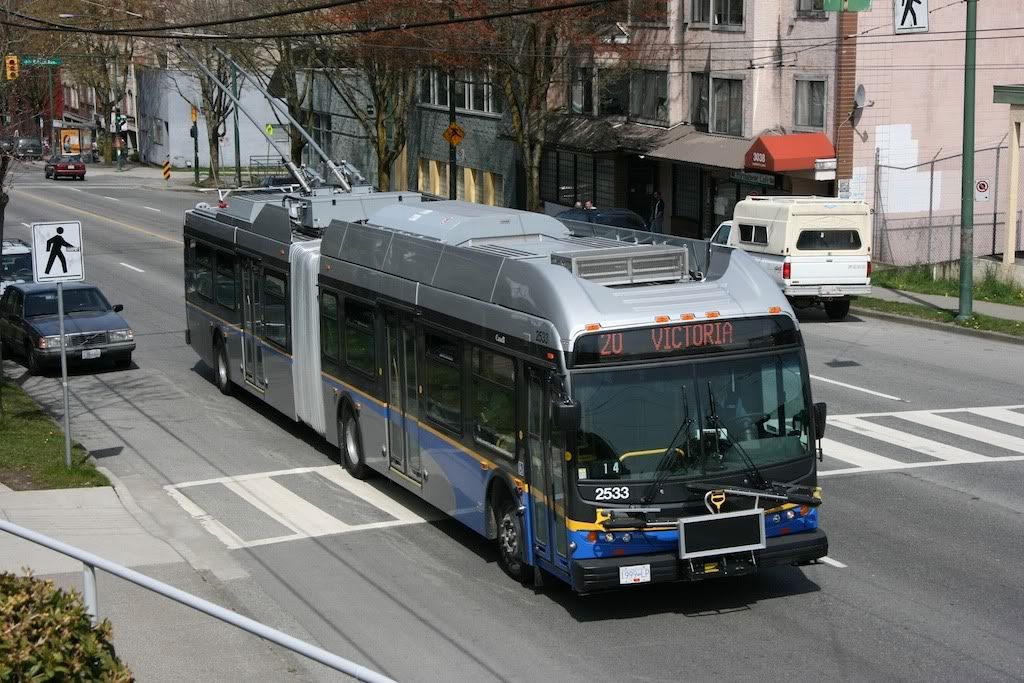Author's posts
Dec 16 2013
Sunday Train: A Vision for Rail in Sustainable 21st Century Transport
 I’m flat out, finishing one and working on another of my two biggest projects for the end of the year ~ the one that I’m finishing has a drop dead deadline of Monday, but I’m hoping to finish it and send it off sometime late tonight ~ and grading and all of the other five-times-a-year term-end rush of work, so I don’t have time to sit down for my normal most-of-Sunday-afternoon to compose a regular Sunday Train.
I’m flat out, finishing one and working on another of my two biggest projects for the end of the year ~ the one that I’m finishing has a drop dead deadline of Monday, but I’m hoping to finish it and send it off sometime late tonight ~ and grading and all of the other five-times-a-year term-end rush of work, so I don’t have time to sit down for my normal most-of-Sunday-afternoon to compose a regular Sunday Train.
However, fear not. Instead of my regular Sunday Train, I am going to present a draft of a contribution I am working on for a longer white paper that involves the Steel Interstate investment that our country needs to be making in electrified, long-haul freight transport. Longer time readers of the Sunday Train may expect to see familiar themes covered in this draft.
If you have any comments, constructive criticism (or even, I guess, non-constructive criticism) I would be happy to hear it. And, of course, you may always raise any issue in Sustainable Energy and Transport that may come to your mind.
Dec 09 2013
Sunday Train: Traveling to our deaths and the fatal Metro North derailment
 Last Sunday Morning, the 5:45am from Poughkeepsie was running through the Bronx with 100-150 passengers aboard, when it sped through a 30mph speed limit curve at 82mph, derailed, over-turning four cars and killing four people.
Last Sunday Morning, the 5:45am from Poughkeepsie was running through the Bronx with 100-150 passengers aboard, when it sped through a 30mph speed limit curve at 82mph, derailed, over-turning four cars and killing four people.
This is a story with some differences in detail from the Spanish fatal derailment this summer, but one common feature: the lack of adequate Positive Train Control signaling on the corridor. In the Spanish case, project cost-shaving led to Positive Train Control signaling being installed on the new High Speed Rail corridor but not on connecting corridors that some hybrid services use to reach towns not directly on the HSR corridor. In the Spanish case, full PTC would not have been required to prevent the fatal accident: ‘The Santiago Train Derailment Could Have Been Prevented with a Euro 6,000 beacon’. As later details emerged it became clear that if two analog “ATSFA’ beacons had been replaced with three digital ‘ATSFA’ beacons, at a cost of €6,000 each, that would have prevented the fatal derailment.
The Metro-North connecting from Poughkeepsie through the Bronx into Manhattan is slated to receive Positive Train Control, as required by current Federal Railway Authority policy, but as recounted by Alan Levy:
Metro-North and the LIRR have been trying to wrangle their way out of the PTC mandate, saying it offers “marginal benefits”; a year and a half ago, the New York Post used the word “outrageous” to describe the PTC mandate, saying it would cost over a billion dollars and that the money could go to capacity improvements instead, such as station parking. Lobbying on behalf of Metro-North and the LIRR, Senator Charles Schumer emphasis mine made sure to amend a proposed Senate transportation bill to give the railroads waivers until 2018, so that they could devote resources to more rush hour capacity from the outer suburbs (such as Ronkonkoma) to Manhattan and fewer to safety. According to Siemens, the work will actually take until 2019, and Siemens says it “has developed PTC specifically for the North American market,” in other words built a bespoke system instead of ETCS. (ACSES was developed by Alstom.)
And that is the top-line point: if we had been more serious and committed about putting PTC on the busiest passenger rail corridors in the country, this fatal derailment would not have occurred.
Dec 02 2013
Sunday Train: ‘the successful communities are going to be the ones who get rail.’
 In covering the upcoming vote on the planned North Metro Rail line in Denver, the Denver Post writes:
In covering the upcoming vote on the planned North Metro Rail line in Denver, the Denver Post writes:
People and circumstances over the years have tried to change the gritty image of Commerce City. There have been high-end homes on its eastern border and a world-class soccer and concert stadium not far from the city’s oil refineries, and even an attempt to wipe the city’s industrial name off of the map and replace it with the more low-key moniker of Derby. But it may be a stop on the Regional Transportation District’s North Metro Rail Line that brings some shine to the center of the city.
They quote the Commerce City Mayor:
“I’m very optimistic about the commercial opportunities that come with transit-oriented development,” said Commerce City Mayor Sean Ford. “Once rail comes, we can develop around it, and I think it will be highly beneficial.”
… as well as the Adams County Commissioner and Chairman of the North Area Transportation Alliance:
“In our world, the successful communities are going to be the ones who get rail,” said Adams County Commissioner Erik Hansen
And on Tuesday night, the Metro North line was approved, for a 2014 start and 2018 completion, when it had been previously set back to 2044 (an oddly exact date that clearly meant, “not now, but maybe later”):
A spontaneous offer from Graham Contracting in February stepped up the plans for the North Metro line after the company teamed with three other private developers and gave the Regional Transportation District’s board of directors a viable, ambitious construction plan, said RTD spokeswoman Pauletta Tonilas.
Nov 25 2013
Sunday Train: Trains & Buses Should Be Friends
 The Salt Lake Tribune adopts the familiar mode-warrior framing in comparing rail and upgraded buses, typically called “BRT” for “Bus Rapid Transit”:
The Salt Lake Tribune adopts the familiar mode-warrior framing in comparing rail and upgraded buses, typically called “BRT” for “Bus Rapid Transit”:
The Utah Transit Authority figures the many new rail lines it opened in the last three years attracted $7 billion to $10 billion worth of new development near stations as a side benefit to improving transportation. Since it spent $2.4 billion on those lines, it sounds like a good return on investment.
But a new study says governments get even more bang for their buck in revitalizing areas if they instead build “bus rapid transit” (BRT) systems. While far cheaper to construct, they attract just as much development.
… which elicits a measured response from the UTA:
The UTA says there is no need for buyer’s remorse for its new TRAX, FrontRunner and streetcar projects – because they do more than revamp areas. But UTA adds that BRT is a focus of its future plans. It is sort of a TRAX on rubber wheels where buses have exclusive lanes, passengers buy tickets from vending machines before boarding on platforms, and buses have priority at intersections.
The “odds and sods” system in the US for funding transit improvements encourages this type of mode-warrior framing … which mode delivers more:
- … bang for the buck
- … diversion of motorists to transit
- … Greenhouse Gas Emissions reduction
- … development impact
- … reduction in the annual slaughter of Americans by motorists
- … amenity to the rider
- … farebox revenue
- … (and etcetera and etcetera) …
And that framing for studies like the one that the Institute for Transport and Development Policy is presently promoting, claiming that BRT delivers 31x the bang for the buck that rail does.
Nov 18 2013
Sunday Train: Is Dirty Ethanol Here to Stay?
 The AP Reports (courtesy of yahoo):
The AP Reports (courtesy of yahoo):
The failure so far of cellulosic fuel is central to the debate over corn-based ethanol, a centerpiece of America’s green-energy strategy. Ethanol from corn has proven far more damaging to the environment than the government predicted, and cellulosic fuel hasn’t emerged as a replacement.
“Cellulosic has been five years away for 20 years now,” said Nathanael Greene, a biofuels expert at the Natural Resources Defense Council. “Now the first projects are up and running, but actually it’s still five years away.”
The administration defended its projections, saying it was trying to use the biofuel law as a way to promote development of cellulosic fuel. But the projections were so far off that, in January, a federal appeals court said the administration improperly let its “aspirations” for cellulosic fuel influence its analysis. Even with the first few plants running, supporters acknowledge there is almost no chance to meet the law’s original yearly targets that top out at 16 billion gallons by 2022. “It’s simply not plausible,” said Jeremy Martin, a biofuels expert at the Union of Concerned Scientists. “2030 is the soonest you can anticipate it to be at that level.”
Green Ethanol still “Five Years Away” … just as they were when I first blogged on this topic in 2007 … while Dirty Ethanol is the mainstay of the US Ethanol mandate. So how long are we to accept Dirty Ethanol as a “bridge” to a Green Ethanol seemingly always right on the five-year horizon?
Nov 11 2013
Sunday Train: Will We Be Ready for the Great 2017 HSR Policy Unlock?
 I’ve posed a question in the title of this week’s Sunday Train that I have no intention of answering myself.
I’ve posed a question in the title of this week’s Sunday Train that I have no intention of answering myself.
The first thing you may have noted is that the title presumes a “Great 2017 Policy Unlock” that is by no means certain. And assuming an event in a title as a lead-in to talking about the likelihood of that event is a long-standing internet link-bait practice.
The second thing, however, is that even that would be focusing on political fortune telling, and the Sunday Train is not normally about making guesses about what will happen. It is more often focused on policy in the sense of thinking about what should happen and, sometimes, what we can do to make it more likely to happen.
The foundation of the Sunday Train is the premise that on our current track, with our current transport and energy systems, we are driving the possibility of retaining a national, modern, industrial economy over a cliff. We are doing that in three ways:
- Our Energy Production and our Transport Systems combined are responsible for a majority of our CO2 emissions, and even if we converted everything else in our economy to be 50% carbon negative ~ sequestering 50% as much CO2 as it present emits ~ our current Energy and Transport systems would be sufficient to drive the globe far enough into Climate Crisis to bring down our national industrial economy;
- And the world has hit Peak Petroleum Production, as is clear from the variety of “scraping the bottom of the barrel” oil and oil-replacement exploitation efforts taking place today, and has started to slide down the other side of the peak, so that an economy as exposed as our own to oil price shocks is going to lose massive ground compared to competing economies that are already positioned to shelter themselves from the impact of oil price shocks
- And we are heading toward the Energy Return on Investment cliff for the fossil fuels we produce ourselves that our current Energy and Transport systems relies upon, and as we slide down that cliff, the economic benefit of that domestic fossil fuel production will progressively decline, leaving us behind any national economies or continental economic systems that seriously pursue sustainable, renewable energy sources that are seeing growing Energy Return on Investment, due to technological progress.
Pick your poison, since any one of them is serious enough to either drive the US economy from the ranks of the core economies into the ranks of the semi-peripheral economies, or even to eliminate our ability to retain a national economy at all.
Given that premise, the “odds of success” in a political forecasting sense is not the focus of the Sunday Train. The focus is rather the prospect for improving those odds. Whether that is improving the odds from a 50% chance of success, or a 1% chance of success to a 2% chance of success, in either event it is worth the investment in effort to try … whether the mere 1/5 improvement in the odds, or the more impressive doubling in the odds, what is won in the event of a win is such a jackpot that its worth the effort to simply improve the odds a little bit.
Nov 04 2013
Sunday Train: The Cross-Rail Chicago Project and Midwest HSR
 The Midwest HSR Association has long been a Chicago-Centric organization, which is fitting because for many of the urban areas in the nine states that are members of the “Midwest Regional Rail Initiative” intercity rail planning organization, Chicago is included among their top three to five intercity travel destinations.
The Midwest HSR Association has long been a Chicago-Centric organization, which is fitting because for many of the urban areas in the nine states that are members of the “Midwest Regional Rail Initiative” intercity rail planning organization, Chicago is included among their top three to five intercity travel destinations.
With the Cross-Rail Chicago proposal, the Midwest HSR Association is proposing to start building from the inside out, providing a set of profits in the Chicago Area that will then provide the through-Chicago system for intercity rail avoiding the difficult “last mile” problem that the California HSR has to tackle in getting into downtown San Francisco and to Los Angeles Union Station. The proposed project proceeds in phases, with each phase addressing a Chicago regional transport need, even as the total project provides the infrastructure that 110mph and 125mph Rapid Passenger Intercity Rail and 220mph “bullet train” HSR can use to connect to Chicago Union Station and O’Hare International Airport.
The phases are:
- Expanding Union Station, making use of two existing through tracks and reconstructing unused mail platforms for passenger use;
- Union Station to O’Hare, reconstructing Metra’s “Milwaukee West” district and building a short section of new rail, initially to a station connecting to the “ATS” people mover extension to the new rental car facility, and eventually via underground stations connecting directly to the O’Hare terminals;
- Reconstructing the St. Charles Air Line elevated tracks along 16th Street to connect the Union Station through tracks to Metra’s Electric and Rock Island Corridors south of Union Station;
- With I-90 extensions northwest of O’Hare to Elgin, and then to Rockford Illinois;
- With I-56 extensions south of the 16th Street Connector to University Park, and then to Kankakee and Champaign
The Midwest HSR Association’s indicative cost estimate for this project is $9.6b, with the Phase One from the 16th Street Connector through Union Station to the O’Hare Transfer Station estimated at $2b.
Oct 30 2013
New Media Economy, Supporting Lesbian Works & Crowdfunding Classic Yuri Anime
cross-posted from Voices on the Square
UPDATE: Now 166 backers, $10,140 funded of $13,000; 78% funded, 22% to go with 9 days remaining.
 What in the Sam Hill is “Yuri Anime”, and what in the Sam Hill does it have to do with supporting Lesbian works?
What in the Sam Hill is “Yuri Anime”, and what in the Sam Hill does it have to do with supporting Lesbian works?
Erica Friedman at Yuricon starts out an explanation of the term “yuri” by writing:
The term Yuri (百合) is used to refer to stories that contain romantic or sexual relationships between girls or women or, sometimes more generally, stories with a lesbian character.
Yuri is not a dominant niche in Japanese manga (ie, serialized graphic novels), but it does hold a place in the market, and sometimes this shows up in anime that are based on either a yuri manga, or a manga with a yuri side-stream.
Now, manga and anime are commercial media, and so Sturgeon’s Law applies: 90% of everything is crud. Indeed, we might say that what makes somebody a “fan” of a genre is an appreciation of not just the 10% of the genre that is good, but an appreciation of some of the 90% that is crud.
Every genre has its history. From what I understand, part of the history of yuri is the “tragic lesbian”. And the “Tragic Lesbian” features strongly in “Oniisama E”, aka Dear Brother, originally created as a manga by the manga-ka (manga artists) Riyoka Ikeda in 1975, and made into an anime by Tezuka Productions in 1991.
Now, I’m not a media reviewer, and you can read Okazu non-review for a non-review or skim the Wikipedia Oniisama_e… page if you need an extended introduction to this melodrama.
However, if you reside in North America, you can, instead, stream it starting with Episode One: The Magnificant One as Nanako Misonoo, a first year student, starts her life in High School and encounters the “stars” of the school, “Hana no Sainte-Juste (Rei), Kaoru-no-kimi (Kaoru), and Miya-sama (Fukiko)” (according to the Wikipedia machine ~ I want to avoid charges of plagiarizing from Wikipedia).
Now, to see that free stream, you’ll have to sign up for a membership at the AnimeSols.com site,
That is not a bootleg stream: that is a legitimate stream under permission of the rights owner.
But, how can a more than twenty-year-old anime series that has never had an English license be available with a legitimate, free streaming?
Well, that is a story about what the AnimeSols.com site is, and what its trying to accomplish.
Oct 28 2013
Sunday Train: Steel Interstate Revolution
 The Steel Interstate is a proposal to pursue dramatic gains in the energy efficiency of long haul freight transport in the United States, resulting in:
The Steel Interstate is a proposal to pursue dramatic gains in the energy efficiency of long haul freight transport in the United States, resulting in:
- Substantial reductions in Petroleum Imports;
- Substantial reductions in Greenhouse Gas emissions;
- Substantially improved protection from Petroleum Supply interruptions;
- Improved productivity for North American manufacturing; and
- Substantial reductions in damage to the existing Asphalt Interstate System
How can it promise all of this? By mining gross inefficiency. The United States has one of the most energy inefficient systems of moving freight long distances available under current technology, and we combine that with an economy that relies heavily on moving freight long distances.
Some of the specific sources of energy efficiency are:
- Moving cargoes in linked electric freight trains offers less air resistance than moving cargoes in individual trucks, because the freight car ahead provides a slipstream for the freight car immediately behind;
- Steel wheel on steel rail has less rolling resistance than rubber tire on asphalt road;
- Electric motors are more efficient than diesel or gasoline internal combustion engines; and
- When braking, electric trains can put a load on their electric motors and generate power, feeding it back onto the line
Overall, long haul electric freight is around 15 times more energy efficient than long haul diesel semi freight. I tend to express this as over ten times the energy efficiency, to allow leeway for possibly longer routings when taking advantage of the Steel Interstate.
Long haul electric freight trains are also more space efficient than long haul truck transport. Freight demands that would require multiple lanes each way just for truck traffic can be readily accommodated on a two track mainline route. This can be done while accommodating a mix of 60mph heavy freight and 100mph fast container freight by including regular extended sections of passing track: the difference between passing track and sidings is that on-schedule faster and slower trains using the passing track remain in motion, rather than one sitting still in a siding waiting for the other to pass.
Finally, the operating cost per ton-mile for electric freight for both 60mph heavy freight and 90mph fast freight is enough lower than the operating cost of long haul trucking that the government can fund a National Steel Interstate with interest subsidies alone, with Access Fees and User Fees refunding the original capital cost of the system ~ initially, funding expansion of the system, and finally funding retiring the bonds.
Oct 21 2013
Sunday Train: A Train Running A Profit is Charging Too Much
This is a repeat of a Sunday Train that originally ran on 24 January 2010
 Note that the statement is abbreviated for the title. The full statement is, a common carrier like a train, bus, or plane that running a profit based on passenger revenue while paying its full operating and capital cost is charging too much for its tickets.
Note that the statement is abbreviated for the title. The full statement is, a common carrier like a train, bus, or plane that running a profit based on passenger revenue while paying its full operating and capital cost is charging too much for its tickets.
The radical abbreviation of the title is in part because of the radical abbreviation of the lie that is commonly used as a frame. The lie is that a common carrier like a train, bus or plane that is paying for its full operating and capital costs out of passenger revenue ought to run a profit, commonly expressed as a charge of, “SERVICE_XYZ is losing money, it needs to be reformed!“, which assumes that Service_XYZ is supposed to be making a profit.
And, of course, in the sense described above, if its a common carrier transport service, of course it shouldn’t be making a profit. And further, if under the above conditions, if its making a profit, you’re doing it wrong. In the sense given above, PROFIT=FAIL.
This is problematic under our economic system, because under our economic system, running a profit on the full cost of production normally means that you are free to continue without substantial outside interference, while not making a profit implies that you have to go cap in hand begging for money to operate. So if the main assertion is correct, we have a situation where you can be doing it wrong, and be free to continue, or be doing it right, and have to constantly beg for permission to continue doing it right.

Recent Comments